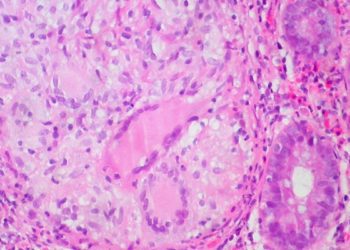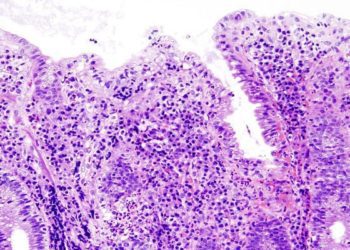Recurrent Salmonella enterica Typhimurium infection disables host protection against intestinal inflammation [PreClinical]
1. Repeated gastrointestinal infections in mice, in this case Salmonella enterica Typhimurium (ST), caused intestinal tissue inflammation which escalated with repeated infections.
2. Increased turnover of intestinal alkaline phosphatase (IAP), related to increased endogenous neuraminidase activity among duodenal enterocytes, was found to be associated with inflammatory bowel disease (IBD). The administration of exogenous IAP or antiviral neuraminidase (Neu) inhibitor Zanavir maintained the IAP levels and prevented IBD onset.
Evidence Rating Level: 2 (Good)
Study Rundown: IBD, which includes both Crohn’s disease and ulcerative colitis (UC), is responsible for a significant disease burden and decreased quality of life across the world. The mechanism underlying these diseases is not completely understood, though both genetic and environmental contributions appear to play a part. Due to previously observed association in hospital admissions for IBD and hospital admissions for bacterial infections, this study explored whether initial and repeated GI infection with Salmonella enterica Typhimurium (ST) accelerated onset of IBD. The study found that even months after cessation of Salmonella infection, inflammation persisted. This inflammation was related to an acquired deficiency of intestinal alkaline phosphatase (IAP), important in detoxifying LPS endotoxin by commensal microorganisms in the host. The deficiency in IAP was mediated by increased breakdown of IAP by Neuraminidase by enterocytes. Overall, the investigators found that both IAP augmentation and neuraminidase inhibition with zanamivir prevented LPS accumulation and provided a therapeutic approach to IBD. Further clinical trials will be necessary to show the efficacy of such treatments in human subjects.
Click to read the study, published in Science Immunology
Relevant Reading: Increased catabolism and decreased unsaturation of ganglioside in patients with inflammatory bowel disease
In-Depth [animal study]: The study found persistent inflammation after months of cessation of additional Salmonella infections. The mechanism was an acquired deficiency of IAP, an enzyme produced by the enterocytes of the intestine. IAP is responsible for dephosphorylating and detoxifying the lipopolysaccharide (LPS) endotoxin produced by many GI commensal bacteria. Salmonella infection was found to increase endogenous neuraminidase (Neu) activity among enterocytes by a Toll-like receptor 4 (TLR4) dependent mechanism. Increased Neu activity was related to increased turnover of IAP, increasing LPS phosphate levels in the intestine, contributing to the inflammation. This study used a murine model C57BL/6J, TLR4–/– and control mice to simulate foodborne GI infections. They used low-titer and nonlethal gastrointestinal infections of a virulent ST virus. To induce chronic colitis, 8-week-old mice were chronically infected 5 times every 4 weeks with ST (2 x 103 cfu). Colitis was assessed biweekly with weight and colitis symptoms of diarrhea, stool consistency, fecal blood and rectal prolapse. In repeated ST infections, inflammatory cytokines mRNA expression levels of chemokine ligand 5 (CCL5) (p<0.001), interleukin-1β (IL-1β) (p<0.001), tumor necrosis factor-α (TNF-α) (p<0.001) and interferon-γ (IFN-γ) (p<0.001) were significantly increased in the colon. Also, histologically, there was a significant increase in infiltration of leukocytes (p<0.001) into the lamina propria, including neutrophils, monocytes and T cells, reduction of goblet cells (p<0.01) and erosion of the epithelial barrier (p<0.001). Administration of calf IAP (cIAP) significantly maintained IAP activity levels in the intestinal tract compared to those with recurrent ST infections (p<0.001). Zanamivir administration resulted in maintenance of normal IAP activity levels in animals with ST infections (p<0.01). Overall, IAP augmentation or Neu inhibition may represent novel candidate therapies that can be used for the treatment of colitis induced by Salmonella infections.
Image: PD
©2018 2 Minute Medicine, Inc. All rights reserved. No works may be reproduced without expressed written consent from 2 Minute Medicine, Inc. Inquire about licensing here. No article should be construed as medical advice and is not intended as such by the authors or by 2 Minute Medicine, Inc.





